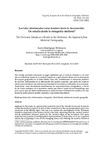Identificador persistente para citar o vincular este elemento:
https://accedacris.ulpgc.es/jspui/handle/10553/25188
| Campo DC | Valor | idioma |
|---|---|---|
| dc.contributor.author | Rodríguez Wittmann, Kevin | en_US |
| dc.date.accessioned | 2018-01-23T03:31:22Z | - |
| dc.date.accessioned | 2018-06-18T06:46:38Z | - |
| dc.date.available | 2018-01-23T03:31:22Z | - |
| dc.date.available | 2018-06-18T06:46:38Z | - |
| dc.date.issued | 2018 | en_US |
| dc.identifier.issn | 1133-598X | en_US |
| dc.identifier.uri | https://accedacris.ulpgc.es/handle/10553/25188 | - |
| dc.description.abstract | Este trabajo pretende acercarnos al papel simbiótico que el Océano Atlántico y las islas que lo conforman tienen en el contexto medieval, y qué relación tienen con la concepción del espacio geográfico de la Edad Media. Para ello, estudiaremos el desarrollo analítico de las Islas Afortunadas en la descripción del mundo conocido, que parte del contexto clásico para establecer una referencia primordial de los límites occidentales de la ecúmene. Tomaremos como herramienta fundamental las representaciones cartográficas, a través de las cuales podemos ver el paulatino cambio que sufre el papel de ese archipiélago, que poco a poco pasa de definir gráficamente la última frontera occidental del mundo a ser una escala de unión entre el mundo conocido y uno recién descubierto. | en_US |
| dc.description.abstract | In this study we approach the symbiotic role of the Atlantic Ocean and its islands within the medieval context, as well as their connection to the way geographical space was conceived in the Middle Ages. Our aim is to analyse the development of the Fortunate Islands in depictions of the known world at the time, departing from the classical context and its established reference points for the western edges of the oecumene. Our main analytical tool consists of cartographical representations, which allow us to see a gradual shift in the archipelago’s role, slowly changing from a role defining the western border of the world, to acting as a nexus between the known world and another, newly discovered one. | en_US |
| dc.format | application/pdf | es |
| dc.language | spa | en_US |
| dc.relation.ispartof | Vegueta: Anuario de la Facultad de Geografía e Historia | en_US |
| dc.source | Vegueta : Anuario de la Facultad de Geografía e Historia [ISSN 1133-598X], n. 18, p. 233-255, (2018) | en_US |
| dc.subject | 55 Historia | en_US |
| dc.subject.other | Islas Afortunadas | en_US |
| dc.subject.other | Cartografía | en_US |
| dc.subject.other | Edad Media | en_US |
| dc.subject.other | Límites del mundo | en_US |
| dc.subject.other | Geografía | en_US |
| dc.subject.other | Fortunate Islands | en_US |
| dc.subject.other | Cartography | en_US |
| dc.subject.other | Middle Ages | en_US |
| dc.subject.other | Limits of the World | en_US |
| dc.subject.other | Geography | en_US |
| dc.title | Las Islas Afortunadas como frontera hacia lo desconocido. Un estudio desde la cartografía medieval | en_US |
| dc.title.alternative | The Fortunate Islands as a Border to the Unknown. An Approach from Medieval Cartography | en_US |
| dc.type | info:eu-repo/semantics/article | en_US |
| dc.type | Article | en_US |
| dc.compliance.driver | 1 | es |
| dc.description.lastpage | 255 | en_US |
| dc.description.firstpage | 233 | en_US |
| dc.relation.volume | 18 | en_US |
| dc.investigacion | Artes y Humanidades | en_US |
| dc.rights.accessrights | info:eu-repo/semantics/openAccess | es |
| dc.type2 | Artículo | en_US |
| dc.utils.revision | Sí | en_US |
| dc.identifier.ulpgc | Sí | en_US |
| dc.description.esci | ESCI | |
| dc.description.fecytq | Q3 | |
| dc.description.fecytpuntuacion | 27,85 | |
| dc.description.dialnetimpact | 0,0 | |
| dc.description.dialnetq | Q1 | |
| dc.description.dialnetd | D3 | |
| dc.description.erihplus | ERIH PLUS | |
| item.fulltext | Con texto completo | - |
| item.grantfulltext | open | - |
| Colección: | Artículos Vegueta. n.18, 2018 | |
Visitas
111
actualizado el 25-ene-2025
Descargas
322
actualizado el 25-ene-2025
Google ScholarTM
Verifica
Comparte
Exporta metadatos
Los elementos en ULPGC accedaCRIS están protegidos por derechos de autor con todos los derechos reservados, a menos que se indique lo contrario.
